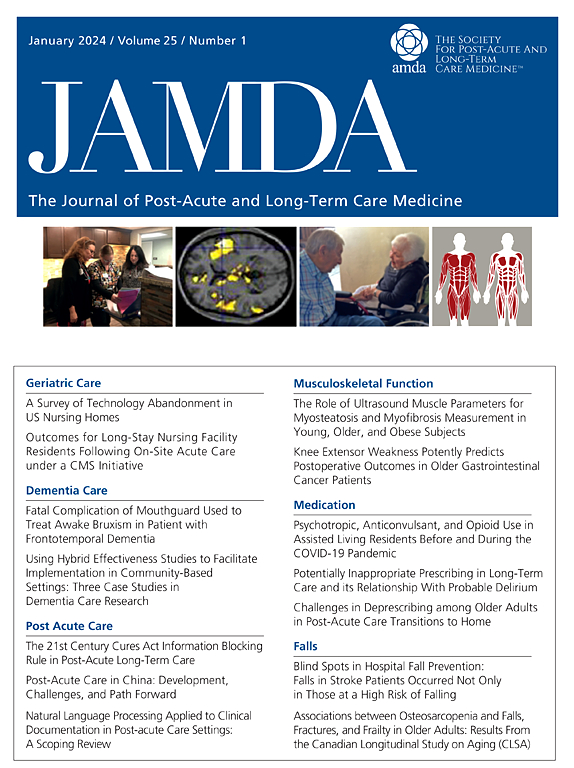Qualitative Study of the Context of Health Information Technology in Sepsis Care Transitions: Facilitators, Barriers, and Strategies for Improvement
IF 4.2
2区 医学
Q2 GERIATRICS & GERONTOLOGY
Journal of the American Medical Directors Association
Pub Date : 2025-05-10
DOI:10.1016/j.jamda.2025.105606
引用次数: 0
Abstract
Objective
To examine how health information technology (HIT) supports timely post-acute home health and outpatient care for sepsis survivors by identifying facilitators, barriers, and proposed strategies.
Design
Qualitative descriptive study.
Setting and Participants
Clinicians, care coordinators, sepsis coordinators, and administrators from 5 US health systems (hospitals and outpatient clinics) and affiliated home health care (HHC) agencies.
Methods
We conducted semi-structured interviews, which were recorded, transcribed, and analyzed using thematic analysis with both deductive and inductive coding. Deductive coding was guided by the Consolidated Framework for Implementation Research to systematically assess barriers and facilitators of the intervention. The analysis achieved more than 90% interrater reliability, and member checking enhanced trustworthiness. After coding was finalized, a query was generated to identify electronic health record (EHR)-related themes that support or hinder health information management in electronic systems.
Results
Sixty-one interviews with 91 participants identified 17 themes related to HIT's role in care transitions for sepsis survivors. HIT facilitated sepsis identification, documentation, communication, information sharing, care coordination, and quality monitoring during hospital-to-home transitions. Barriers included missing, delayed, or inaccessible information across disparate EHR systems. Proposed strategies include establishing interoperable EHR systems and leveraging HIT tools to improve identification, communication, and care coordination for timely follow-up care, with continuous monitoring of functionality.
Conclusions and Implications
HIT plays a central role in care transitions, improving information sharing, communication, and coordination, ultimately enhancing patient outcomes and safety. Administrators can improve data integration and quality monitoring with interoperable systems, and policymakers can promote adoption through financial incentives. The advancement of technologies, including HIT tools, may offer opportunities to further optimize sepsis identification, communication, and care coordination, promoting seamless care transitions.
脓毒症护理转变中卫生信息技术背景的定性研究:促进因素、障碍和改进策略
目的探讨健康信息技术(HIT)如何通过识别促进因素、障碍和建议的策略,支持败血症幸存者的急性后家庭健康和门诊护理。设计定性描述性研究。来自美国5个卫生系统(医院和门诊诊所)和附属家庭卫生保健(HHC)机构的临床医生、护理协调员、败血症协调员和管理人员。方法采用半结构化访谈,对访谈内容进行记录、转录,并采用演绎编码和归纳编码相结合的主题分析方法进行分析。演绎编码在实施研究综合框架的指导下,系统地评估干预的障碍和促进因素。分析实现了90%以上的互信度,成员检查提高了可信度。编码完成后,生成一个查询,以确定支持或阻碍电子系统中健康信息管理的电子健康记录(EHR)相关主题。结果对91名参与者进行了61次访谈,确定了与HIT在败血症幸存者护理过渡中的作用相关的17个主题。HIT促进了败血症的识别、记录、沟通、信息共享、护理协调和医院到家庭过渡期间的质量监测。障碍包括在不同的EHR系统中丢失、延迟或无法访问的信息。建议的策略包括建立可互操作的电子病历系统,并利用HIT工具改进识别、沟通和护理协调,以便及时进行后续护理,并对功能进行持续监测。结论和意义it在护理转变中发挥核心作用,改善信息共享、沟通和协调,最终提高患者的预后和安全性。管理员可以使用可互操作的系统改进数据集成和质量监控,决策者可以通过财政激励措施促进采用。包括HIT工具在内的技术进步可能为进一步优化败血症识别、沟通和护理协调提供机会,促进无缝护理过渡。
本文章由计算机程序翻译,如有差异,请以英文原文为准。
求助全文
约1分钟内获得全文
求助全文
来源期刊
CiteScore
11.10
自引率
6.60%
发文量
472
审稿时长
44 days
期刊介绍:
JAMDA, the official journal of AMDA - The Society for Post-Acute and Long-Term Care Medicine, is a leading peer-reviewed publication that offers practical information and research geared towards healthcare professionals in the post-acute and long-term care fields. It is also a valuable resource for policy-makers, organizational leaders, educators, and advocates.
The journal provides essential information for various healthcare professionals such as medical directors, attending physicians, nurses, consultant pharmacists, geriatric psychiatrists, nurse practitioners, physician assistants, physical and occupational therapists, social workers, and others involved in providing, overseeing, and promoting quality

 求助内容:
求助内容: 应助结果提醒方式:
应助结果提醒方式:


